
A reusable launch vehicle has parts that can be recovered and reflown, while carrying payloads from the surface to outer space. Rocket stages are the most common launch vehicle parts aimed for reuse. Smaller parts such as rocket engines and boosters can also be reused, though reusable spacecraft may be launched on top of an expendable launch vehicle. Reusable launch vehicles do not need to make these parts for each launch, therefore reducing its launch cost significantly. However, these benefits are diminished by the cost of recovery and refurbishment.

Vostok was a family of rockets derived from the Soviet R-7 Semyorka ICBM and was designed for the human spaceflight programme. This family of rockets launched the first artificial satellite and the first crewed spacecraft (Vostok) in human history. It was a subset of the R-7 family of rockets.
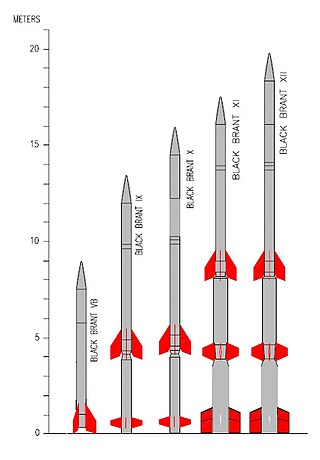
The Black Brant is a family of Canadian-designed sounding rockets originally built by Bristol Aerospace, since absorbed by Magellan Aerospace in Winnipeg, Manitoba. Over 800 Black Brants of various versions have been launched since they were first produced in 1961, and the type remains one of the most popular sounding rockets. They have been repeatedly used by the Canadian Space Agency and NASA.

Skylark was a family of British sounding rockets. It was operational between 1957 and 2005.
The Petrel was a British sounding rocket. The Petrel 1 was launched, like the Skua 1, with 3 Chick booster rockets. The Chick motors were fitted into a booster carriage that also carried the two parachutes that brought it back to earth for re-use. The Petrel 1 was 3.34 m long, had a diameter of 19 cm and reached a maximum altitude of 140 kilometres. It was fired from a 10-metre-long (33 ft) launch tube.

The Dragon is a two-stage French solid propellant sounding rocket used for high altitude research between 1962 and 1973. It belonged thereby to a family of solid-propellant rockets derived from the Bélier, including the Centaure, the Dauphin and the Éridan.

The Dauphin is a French sounding rocket, flown six times between 1967 and 1979. It consists of a modification of the first stage of the Dragon with a larger payload nosecone.
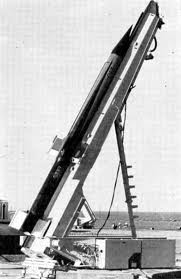
Centaure was a two-stage French sounding rocket consisting of a Venus first stage and a Belier second stage. It belongs to a family of solid-propellant rockets consisting of the Belier, Centaure, Dragon, Dauphin, and Eridan.

The Uchinoura Space Center is a space launch facility in the Japanese town of Kimotsuki, Kagoshima Prefecture. Before the establishment of the JAXA space agency in 2003, it was simply called the Kagoshima Space Center (鹿児島宇宙空間観測所) (KSC). All of Japan's scientific satellites were launched from Uchinoura prior to the M-V launch vehicles being decommissioned in 2006. It continues to be used for suborbital launches, stratospheric balloons and has also been used for the Epsilon orbital launch vehicle. Additionally, the center has antennas for communication with interplanetary space probes.

Lambda is the name of a series of Japanese carrier rockets. It consisted of the types Lambda 2, LSC-3, Lambda 3, Lambda 3H, Lambda 4S, Lambda 4SC, and Lambda 4T developed jointly by Institute of Industrial Science of the University of Tokyo, Institute of Space and Astronautical Science of the University of Tokyo, and Prince Motor Company, which merged with Nissan in 1966.
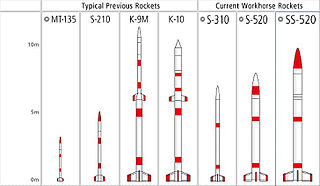
S-Series is a fleet of sounding rockets funded by the Japan Aerospace Exploration Agency (JAXA) that have been in service since the late 1960s. Manufactured by IHI Aerospace and operated by the Institute of Space and Astronautical Science (ISAS). The nomenclature of the S-Series rockets is the number of "S"s indicates the number of stages, and the following number details the diameter of the craft in millimeters. For example, the S-310 is a single stage rocket with a diameter of 310 mm.
Malemute is the designation of an American sounding rocket family. The original Malemute had a maximum flight altitude of 165 km, a liftoff thrust of 57.00 kN, a total mass of 100 kg, a diameter of 0.41 m and a total length of 2.40 m. It was a single stage vehicle powered by a Thiokol Malemute TU-758 engine, operated by Sandia National Laboratories (SNL).
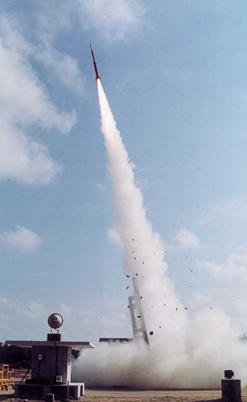
Thumba Equatorial Rocket Launching Station (TERLS) is an Indian rocket launching site established on 21 November 1963. Operated by the Indian Space Research Organisation (ISRO), it is located in Thumba, Thiruvananthapuram, which is near the southwestern tip of mainland India, very close to Earth's magnetic equator. It is currently used by ISRO for launching sounding rockets.
Rehbar is a series of sounding rockets launched into the upper atmosphere by Pakistan's Space and Upper Atmosphere Research Commission (SUPARCO). Rehbar-I was the first rocket launched by SUPARCO, on 7 June 1962. Rehbar-I was a two-staged solid fuel rocket.

The Thor-Burner was an American expendable launch system, a member of the Thor rocket family. It consisted of a Thor missile, with one or two Burner upper stages. It was used between 1965 and 1976 to orbit a number of satellites, most commonly Defense Meteorological Satellite Program (DMSP) weather satellites. Twenty-four were launched, of which two failed. It weighed 51,810 kg and was 24 metres tall.
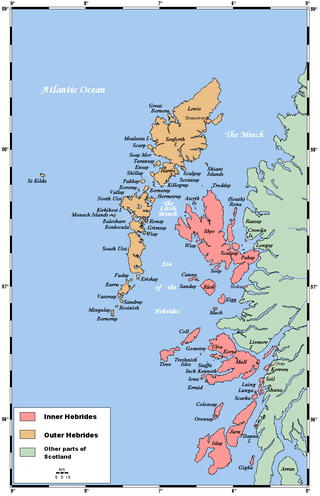
The flora and fauna of the Outer Hebrides in northwest Scotland comprises a unique and diverse ecosystem. A long archipelago, set on the eastern shores of the Atlantic Ocean, it attracts a wide variety of seabirds, and thanks to the Gulf Stream a climate more mild than might be expected at this latitude. Because it is on the Gulf Stream, it also occasionally gets exotic visitors.

Rohini is a series of sounding rockets developed by the Indian Space Research Organisation (ISRO) for meteorological and atmospheric study. These sounding rockets are capable of carrying payloads of 2 to 200 kilograms between altitudes of 100 to 500 kilometres. The ISRO currently uses RH-200, RH-300,Mk-II, RH-560 Mk-II and RH-560 Mk-III rockets, which are launched from the Thumba Equatorial Rocket Launching Station (TERLS) in Thumba and the Satish Dhawan Space Centre in Sriharikota.
The RX rocket family is a series of solid-fuel rockets developed by the Indonesian National Institute of Aeronautics and Space (LAPAN).
The Interarmy Special Vehicles Test Centre (CIEES) (French: Centre Interarmées d'Essais d'Engins Spéciaux) was France's first space launch and ballistic missile testing facility. Outside France, the facility is often referred to by the name of the nearest town, Hammaguir (also called Hammaguira). It was established on 24 April 1947, by ministerial decree as the Special Weapons Test Center (CEES, Centre d'essais d'engins spéciaux) for use by the French Army. In 1948, it was turned over to the French Air Force, who renamed it CIEES. Its remote location in the middle of the Saharan Desert and its relative closeness to the Equator (compared with Metropolitan France) made it an attractive launch site for missiles and orbital rockets.













